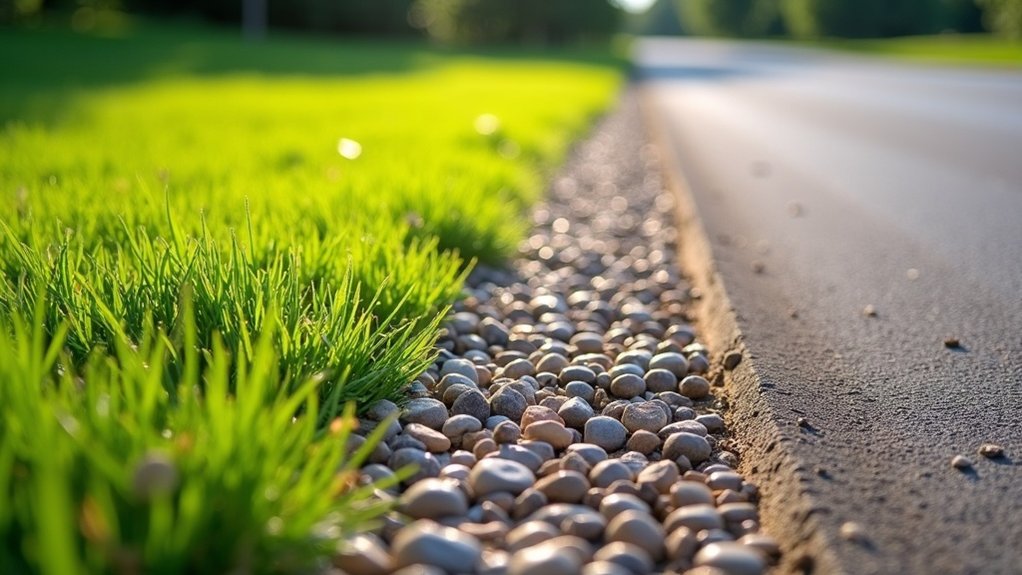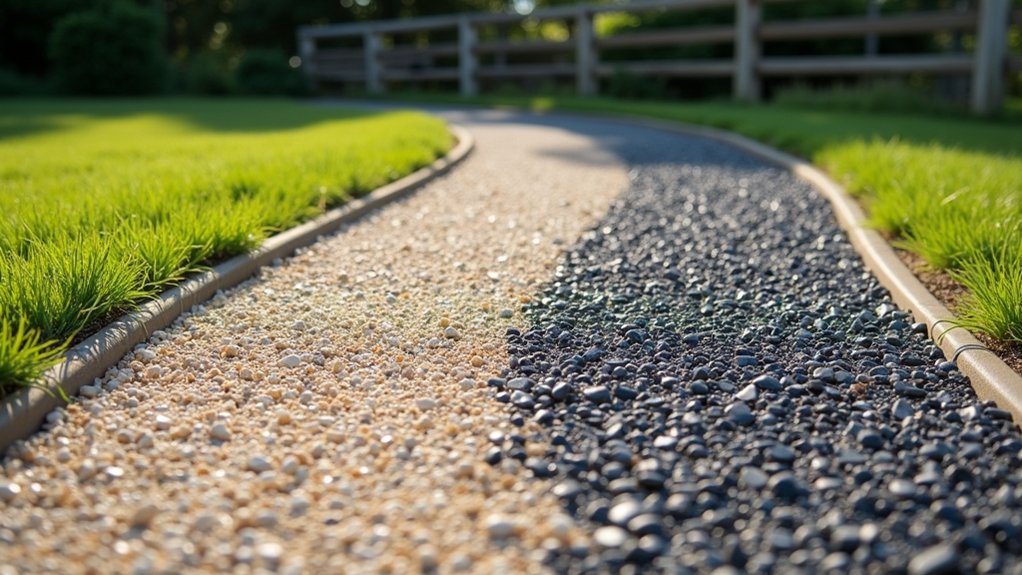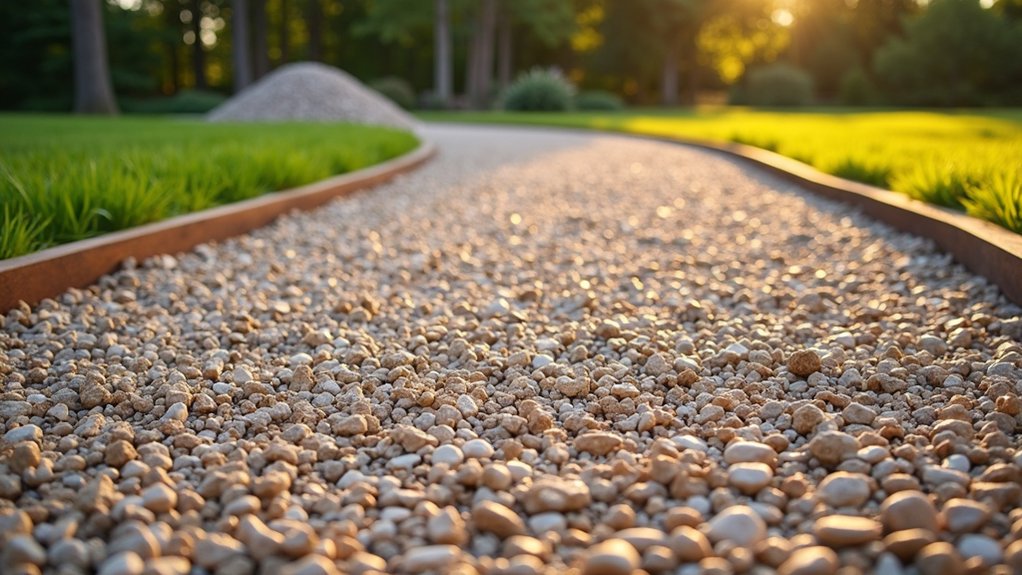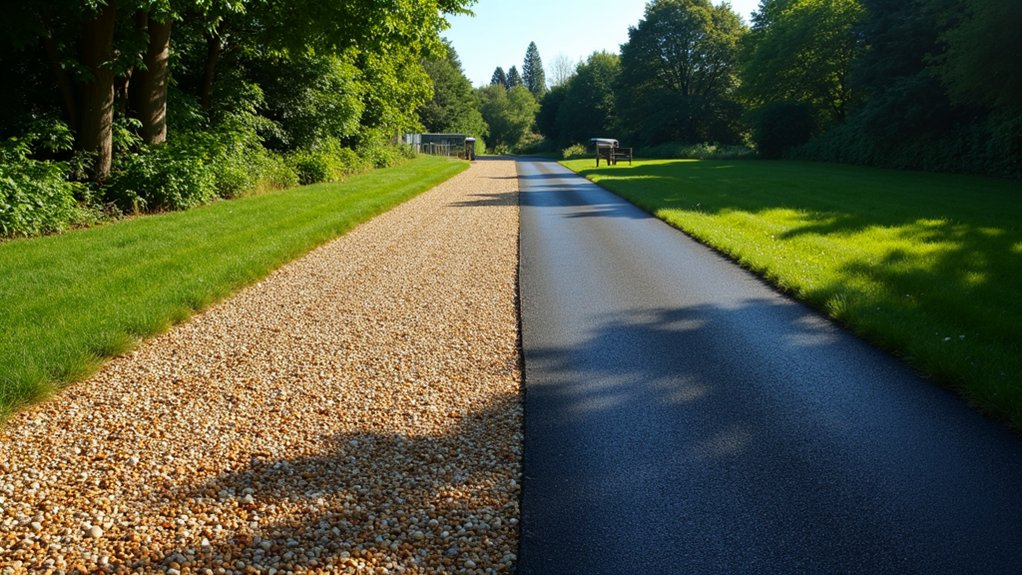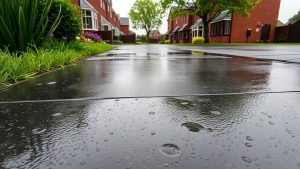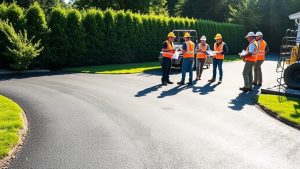To prevent gravel from spilling onto roads and lawns, start by preparing a solid foundation. Excavate to a depth of 10 to 15 cm, then install a robust edging material like aluminium or stone to keep the gravel contained. Ensure the gravel is laid to a depth of 5 to 10 cm for stability. Regularly maintain the edges and compact the surface. Also, consider implementing weed control measures to keep your gravel in place. These steps will help achieve a neat appearance and long-lasting results.
Table of Contents
ToggleKey Takeaways
- Install sturdy edging materials like aluminium or stone to keep gravel contained and stop it spilling onto roads and lawns.
- Maintain a gravel depth of 5-10 cm to lower the chance of spillage and improve stability.
- Ensure a gentle slope of 2-4% away from roads and lawns to aid drainage and reduce gravel movement.
- Place a weed barrier fabric beneath the gravel to stop weeds from growing, which can destabilise the gravel and lead to spills.
- Regularly check for potholes or damaged edges, and fill them in to keep the surface compact and minimise gravel loss.
Foundation Preparation for Gravel Containment
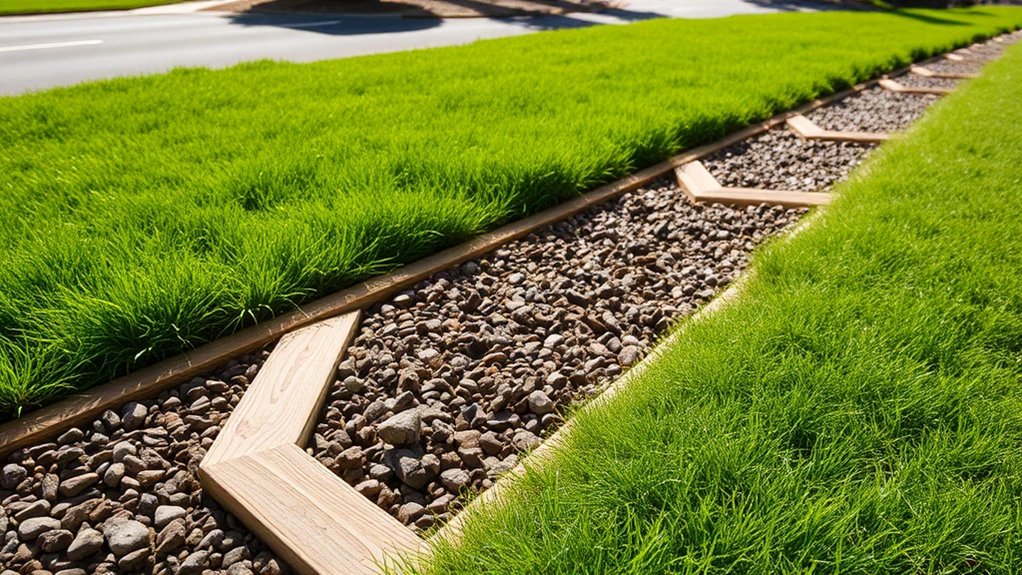
To ensure your gravel containment is effective, start with proper foundation preparation. Excavate to a depth of 10 to 15 centimetres, removing grass, roots, and topsoil for stability. Level the area accurately, keeping the gravel surface flush with the surrounding ground to prevent uneven edges. A proper gravel base allows rainwater to drain away, preventing rot and mold.
On sloped sites, create steps or use pressure-treated timber to maintain a level surface. For the base layer, use coarse stones such as “¾ inch minus” or “#57 clean stone,” mixed with smaller gravel for better compaction. Before adding gravel, lay geotextile fabric to stop it from migrating into the soil, securing it well. This careful preparation is vital for effective gravel containment and to avoid future shifts.
Understanding Edging Materials
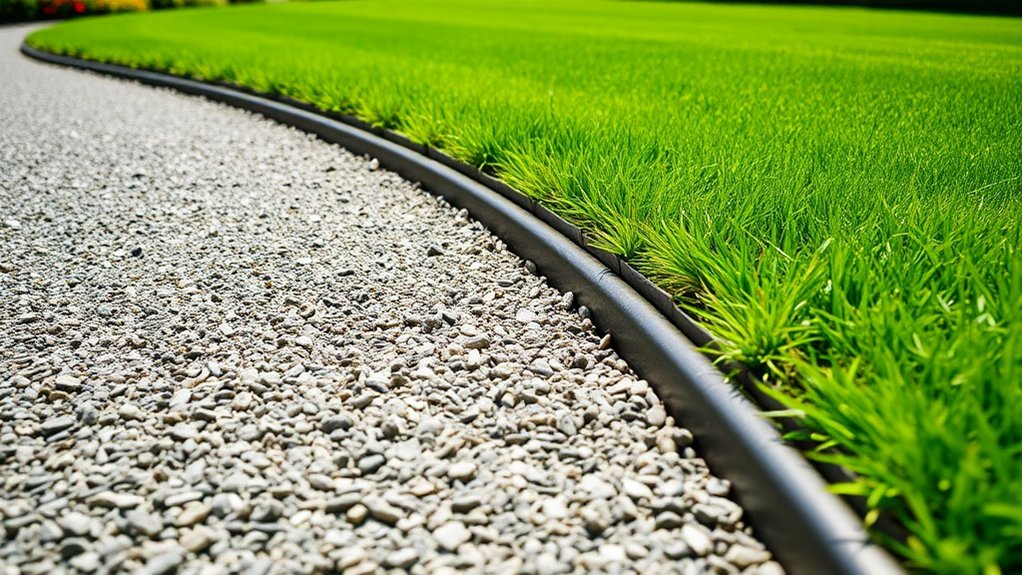
Proper foundation preparation for gravel containment is crucial when selecting suitable edging materials, which help maintain the integrity of your gravel installation. There are various options available, each with its own advantages. Plastic edging is lightweight and affordable, making it ideal for temporary setups. Aluminium strips provide durability and a sleek look. On the other hand, stone-based materials offer a classic aesthetic but require more effort to install. Natural stone cobblestone edging adds a rustic touch but needs regular maintenance. Lastly, rubber and composite options are flexible and eco-friendly, though they may not be as long-lasting. Assessing these materials will help you choose the right edging solution for your gravel project, ensuring effective containment and enhancing your landscape’s appeal.
Proper Edging Installation Techniques
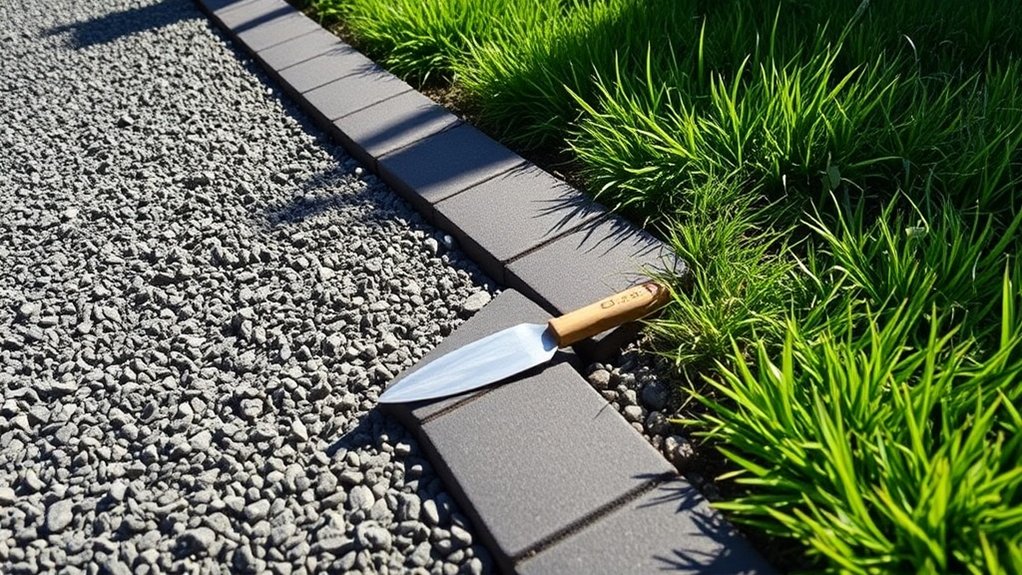
When selecting edging materials, think about their durability and how well they fit with your garden’s design to ensure they last. Stone edging offers a timeless and durable aesthetic that is popular for gravel driveways. Once you’ve picked your materials, it’s crucial to secure them correctly; proper alignment and stability will stop gravel from spilling over and improve the look of your garden.
Choosing Edging Materials
Choosing the right edging materials is crucial for keeping gravel contained and enhancing your garden’s appearance. Here’s a breakdown of your options:
- Plastic Landscape Edging: An affordable and flexible choice, but it can shift in areas with freeze-thaw cycles.
- Steel Edging: Known for its durability, steel can withstand vehicle damage and offers custom shapes, though it tends to be pricier.
- Rubber Edging: Eco-friendly and versatile, it’s great for creating unique garden designs.
- Concrete and Brick: These materials provide a long-lasting, classic look but generally require professional installation.
- Wood: Adds a rustic charm but is susceptible to degradation over time.
Securing Edging Properly
To secure your edging effectively, start by preparing and marking the path where you’ll install it for a clean layout. Use stakes, string, or spray paint to define the edges, ensuring your trench can accommodate the materials and gravel.
Dig a trench about 5 to 7.5 cm deep with a square-edged spade for clean sides. Lay a base of sand or crushed stone and compact it for stability. If you’re using stone or concrete blocks, apply masonry adhesive and allow it to cure for 24 to 48 hours.
For flexible edging, use landscape pins to enhance durability. Finally, check that all sections fit snugly with no gaps, using proper techniques to prevent gravel spillage.
Determining Gravel Depth
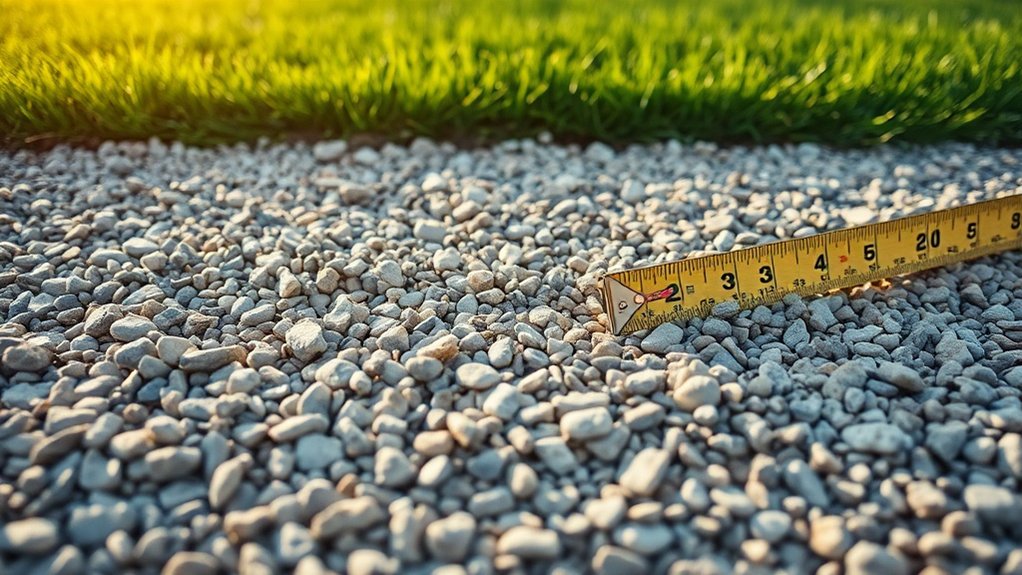
Determining the right gravel depth is crucial for a stable and functional surface. Here are some key points to consider:
- Standard applications generally require a depth of 5 to 10 cm for effective gravel layering.
- Paths and driveways typically need about 5 to 8 cm, striking a balance between stability and cost.
- Heavy traffic areas may necessitate deeper layers, around 10 to 15 cm, to improve drainage and support. Proper compaction is essential for long-lasting strength.
Using accurate volume calculations will help ensure you buy the correct amount of gravel.
Keeping a consistent depth across your area reduces weak spots, minimizing the risk of spillage onto roads and gardens.
Thoughtful planning results in a more durable and visually appealing surface.
Effective Compaction Techniques
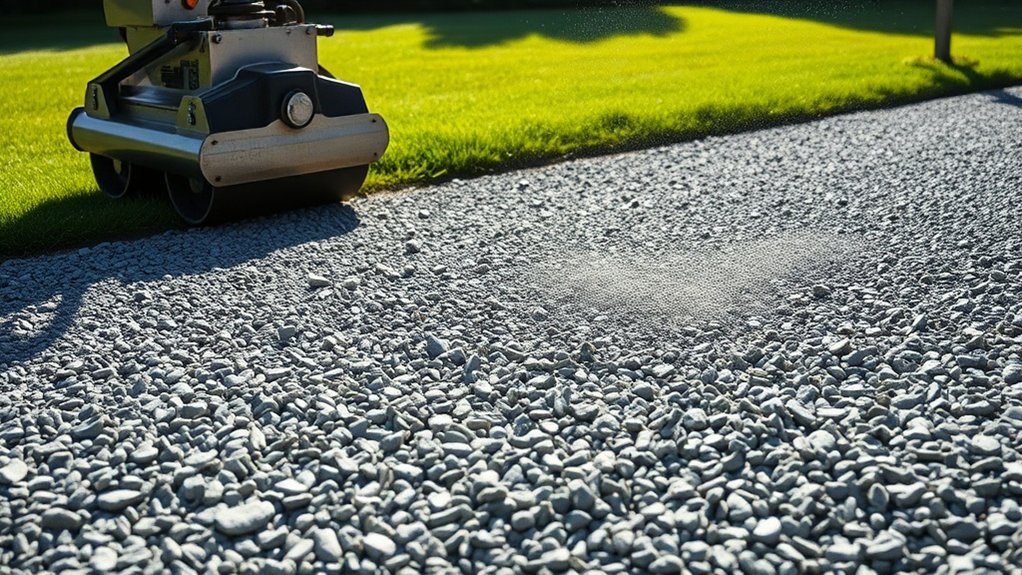
Effective compaction is essential for a stable gravel surface that withstands spills and shifting. Start with suitable compaction methods: use plate compactors for smaller areas and vibratory compactors for larger expanses.
Begin at one edge, moving in straight, overlapping lines to ensure consistent gravel density. Pay particular attention to corners, as these are prone to shifting.
It’s important to maintain the right moisture content to help particles bind together, and level the ground before laying gravel.
Apply gravel in uniform layers, compacting thinner layers for better results. After the initial compaction, inspect for any soft spots and re-compact as necessary.
Vary your rolling patterns to achieve uniform compaction. With proper preparation and technique, you can create durable, stable gravel surfaces.
Utilizing Permeable Grids or Pavers
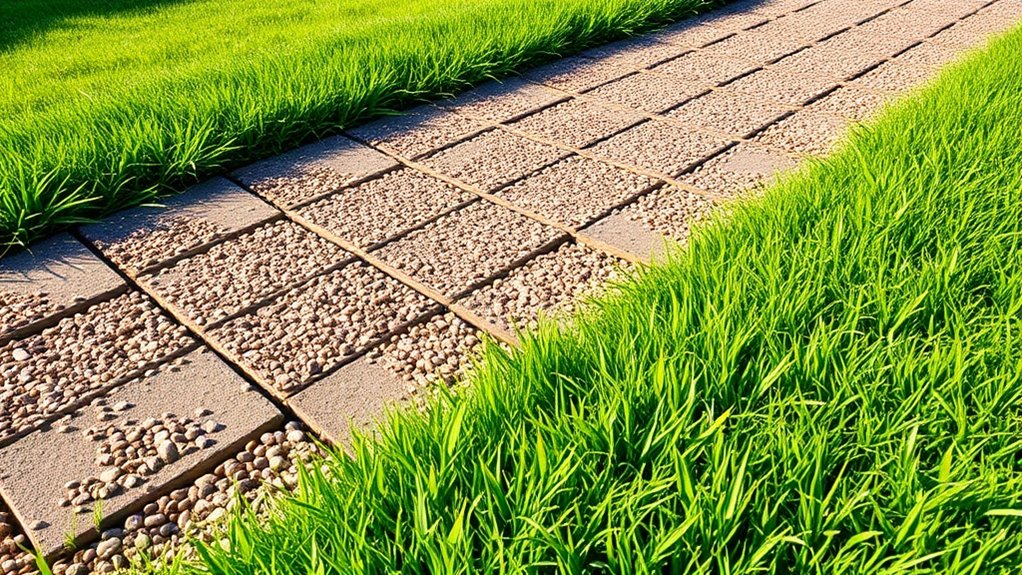
Once you’ve established a solid foundation through effective compaction, you can further enhance the stability of your gravel by using permeable grids or pavers.
These interlocking systems keep gravel securely in place, reducing displacement and improving durability.
Here are some key benefits of permeable grids:
- Open cell design allows rainwater to infiltrate the ground, helping to minimise runoff and support groundwater replenishment.
- Sturdy honeycomb structures ensure gravel stays in position, providing even load distribution and maintaining the integrity of driveways or pathways.
- Built-in geotextile backing controls weeds and prevents gravel from shifting, making maintenance easier.
For effective paver installation, ensure proper placement and infill below the surface. Additionally, permeable grids contribute to groundwater recharge, enhancing the overall health of local ecosystems.
While some gravel movement may still occur, these systems significantly reduce erosion and the need for frequent maintenance, making them an excellent option for stabilising gravel surfaces.
Importance of Drainage and Slope
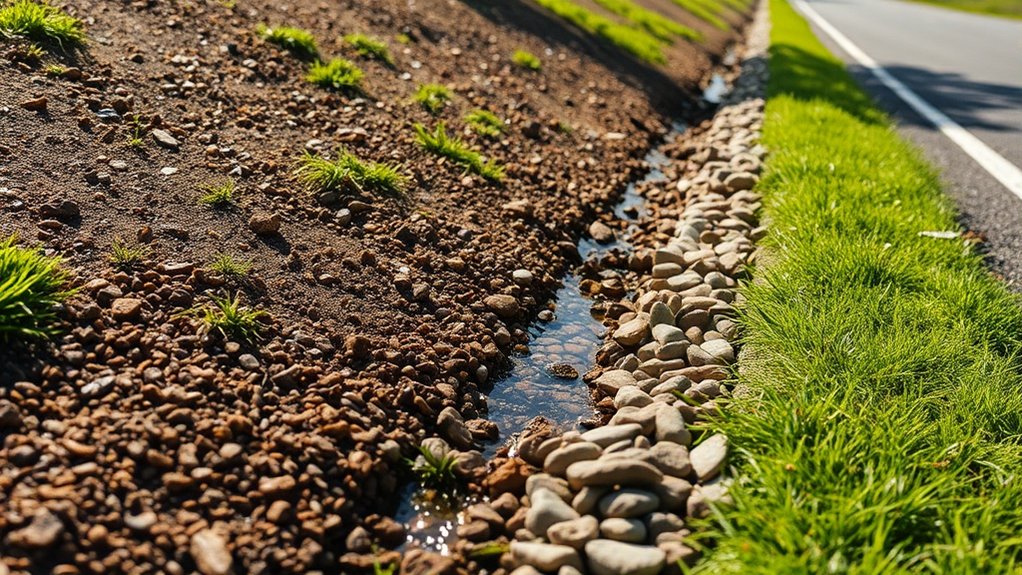
Proper drainage and slope are vital for the upkeep of gravel surfaces. Establishing a consistent slope of 2-4% away from buildings ensures that water flows easily, preventing pooling and erosion.
For gentle slopes, maintain a uniform grade, while moderate slopes should have drainage breaks every 100-150 feet. In the case of steep slopes, consider adding multiple drainage points and stabilisation measures.
Before regrading, it’s important to remove old gravel and any organic material to achieve a stable subgrade. Use a long straightedge and level to check the slope’s accuracy, which will improve drainage efficiency.
Vegetation Control and Maintenance
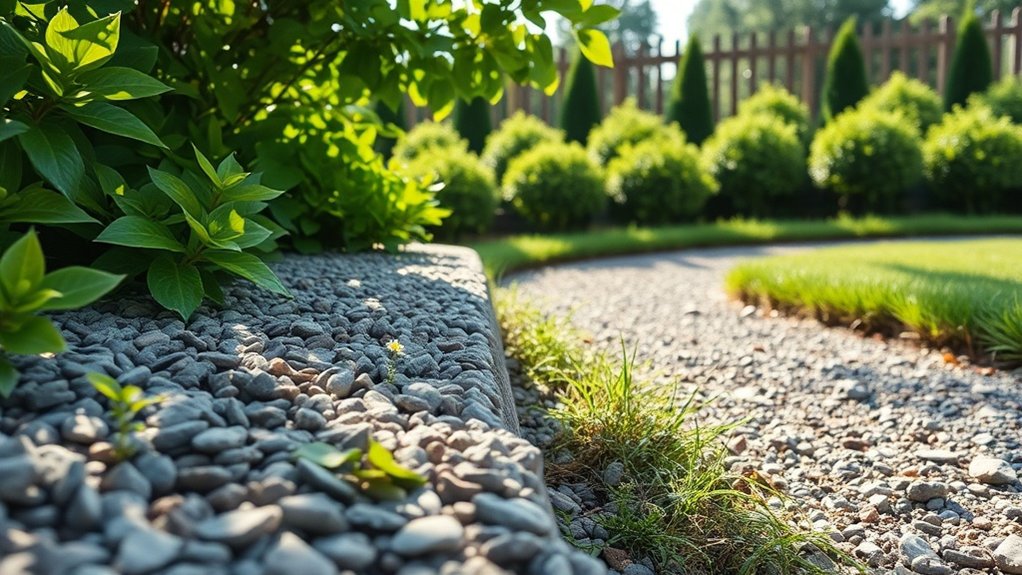
To keep your gravel surfaces looking their best, effective weed control is essential.
Regular upkeep, such as checking for new weeds and removing them promptly, can significantly prevent their growth.
Employing methods like laying down landscape fabric and using targeted chemical treatments can help ensure your gravel areas remain both practical and visually pleasing.
Effective Weed Control
To keep gravel surfaces looking good and lasting longer, controlling weeds is crucial. Start by identifying the weeds and opting for organic methods over chemical treatments.
Here are some effective strategies:
- Corn gluten meal: Apply in spring to prevent weed seeds from germinating.
- Solarisation: Cover the gravel with clear plastic to kill weeds over time.
- Flame weeders: Use a propane torch for tackling small, annual weeds.
Also, consider using physical barriers like landscape fabric or biodegradable options such as newspaper, which block light and hinder growth. Additionally, regular inspections and prompt removal of weeds can help maintain a tidy, weed-free gravel area, similar to how weed management on resin driveways is practiced for optimal results.
For the best results, regularly check for emerging weeds and remove them promptly to maintain a tidy, weed-free gravel area.
Regular Maintenance Practices
Regular maintenance practices are crucial for keeping gravel surfaces intact and preventing spills. Consistent trimming of vegetation helps control unwanted plant growth that can displace gravel. Aim to trim grasses and shrubs within a 1 to 3-foot buffer to maintain visibility and reduce vehicle encroachment.
Additionally, planting deep-rooted, drought-resistant species can help stabilise the soil and absorb runoff, which minimises erosion. Regular inspections and pruning of tree roots are also important to prevent uplift and cracking beneath the gravel.
Seasonal removal of organic debris is essential, as it helps maintain compaction and prevents mixing with the gravel.
Vegetation Management Techniques
Effective vegetation management techniques are vital for reducing gravel spills and maintaining the quality of gravel surfaces. Here are some straightforward strategies to consider:
- Lay landscape fabric beneath the gravel to prevent weed growth while still allowing water to drain through.
- Choose native plants such as manzanita and willow, which thrive in gravelly conditions and help stabilise the soil to minimise erosion.
- Use dense ground cover around gravel edges to restrict the spread of weed seeds and create a natural barrier.
Regular monitoring is crucial to ensure these barriers are effective, keeping gravel from spilling onto roads and gardens.
Weed Prevention Strategies
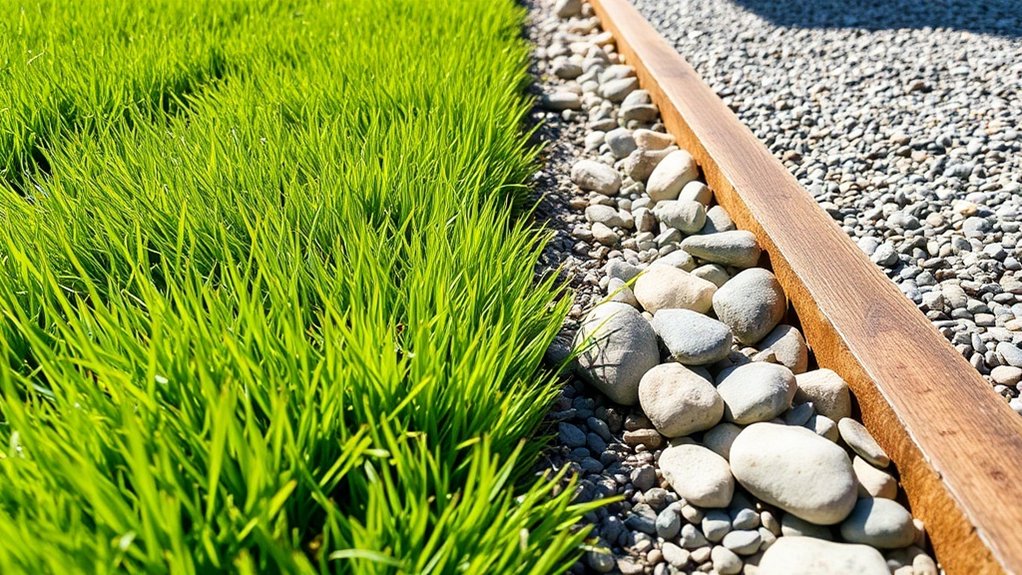
To effectively prevent weeds from taking over your gravel areas, it’s essential to use a mix of strategies.
Start by laying down weed barrier fabric beneath your gravel; this will stop weeds from growing while still allowing water to drain. Opt for biodegradable options to lessen your environmental footprint.
Adding organic mulch, like wood chips, alongside the gravel can help suppress weeds, but ensure it doesn’t trap too much moisture. Regularly check and fix any overlaps in the fabric to keep it working properly.
You can also manage existing weeds through hand-pulling or flame weeding.
Finally, maintaining a thick layer of gravel (around 5-7.5 cm) will limit light penetration, making it harder for weeds to thrive.
With consistent effort and the right methods, you can keep your gravel areas free from weeds.
Regular Maintenance for Longevity

Maintaining your gravel surfaces is crucial for ensuring their longevity and optimal performance. Here are some straightforward strategies for gravel maintenance that can enhance durability and minimise spills:
- Rake the gravel regularly to clear away debris, which helps with drainage and keeps the surface intact.
- Check for potholes and damaged edges, filling them in promptly to prevent further erosion.
- Add a fresh top layer every 2-3 years to replenish worn areas and maintain a consistent gravel depth.
These simple steps can make a significant difference in the lifespan of your gravel surfaces.
Best Practices for Gravel Stabilization
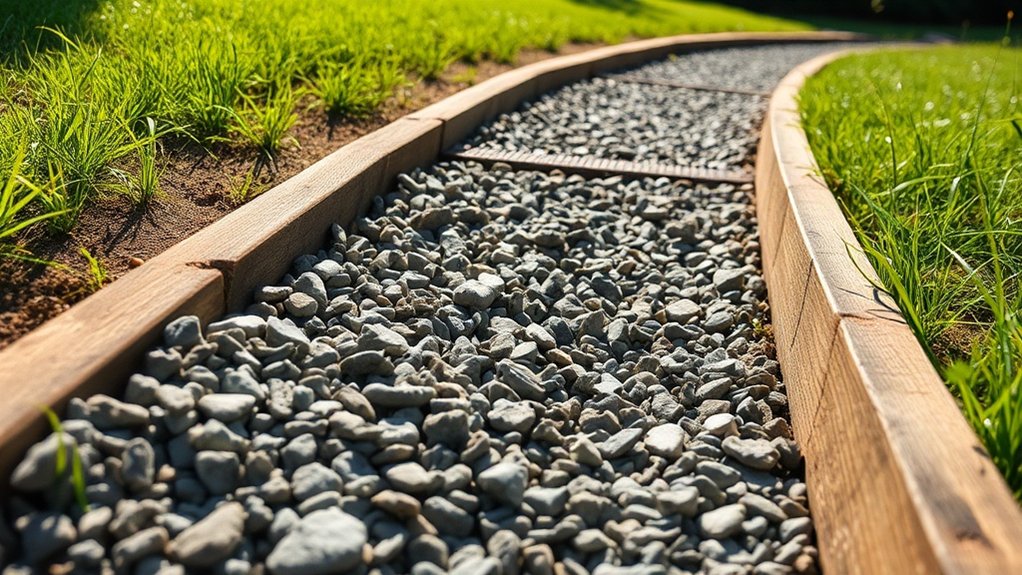
Gravel surfaces are versatile and visually appealing, but they can easily become disorganised without proper stabilisation. To keep gravel in place, consider mechanical methods such as geogrids and compaction, which help lock the aggregate particles together and reduce movement.
Chemical stabilisation, using materials like cement or bitumen, can create solid layers that bind the particles effectively. Biological stabilisers, such as enzymes, can also improve cohesion and reduce dust.
For best results, combine these techniques. For example, using biological agents with compaction can enhance long-term stability.
Ensure proper grading to direct water runoff away from the gravel, which will further increase its durability. Also, choose the right aggregate size based on the expected traffic; this will help maintain the integrity and appearance of your gravel surface.
Aesthetic Considerations for Gravel Containment
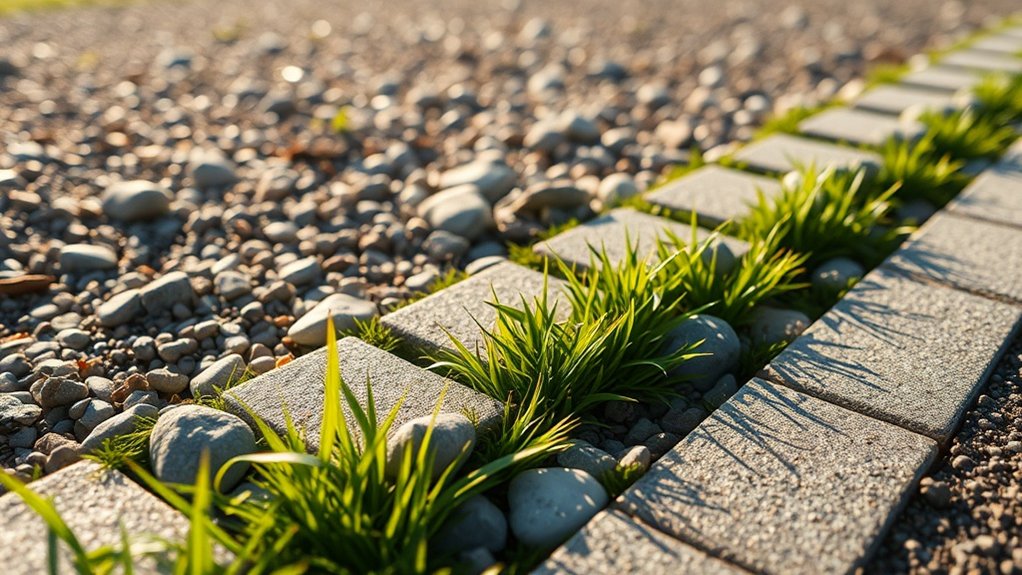
When selecting gravel for your garden, think about how colour and texture can enhance the overall look.
Using darker slate chips alongside lighter plants creates a striking contrast, while different gravel textures can add depth and interest.
Additionally, consider decorative edging options like river stones or cobblestones; they can improve both the functionality and aesthetics of your gravel containment.
Color and Texture Choices
Choosing the right colours and textures can significantly improve gravel containment and the overall look of your garden. Here are some effective combinations to consider:
- Lighter shades like cream or beige offer a gentle contrast, clearly defining gravel boundaries without being too harsh.
- Darker browns naturally blend with the earth, helping to hide any spills and complementing the soil nicely.
- Crushed gravel with sharp edges locks together well, providing stability and minimising displacement.
These choices not only serve a practical purpose but also enhance the visual appeal of your outdoor space.
Decorative Edging Options
Choosing decorative edging not only boosts the visual appeal of your gravel areas but also serves a practical purpose by keeping the gravel contained. Selecting the right material can enhance your garden’s look while ensuring the gravel stays in place.
| Edging Material | Aesthetic Appeal |
|---|---|
| Stone | Natural appearance, durable, blends well with surroundings |
| Metal | Sleek, modern design, low maintenance |
| Concrete & Brick | Custom finishes, strong definition |
| Wood & Composite | Rustic charm, cost-effective, weather-resistant |
| Fence Edging | Versatile styles, adds decorative touch |
Each edging style offers distinct aesthetics, balancing functionality with visual appeal. Consider your needs and preferences to select the best option for your gravel containment.
Frequently Asked Questions
What Types of Gravel Are Best for Driveways and Walkways?
For driveways and walkways, consider using crushed stone for durability or decorative gravel like pea gravel for a more attractive finish. Each type of gravel offers different benefits, affecting stability, drainage, and appearance in your outdoor area. For instance, crushed stone provides a solid base for vehicles, while pea gravel can enhance the visual appeal of a garden path.
How Do I Choose the Right Edging Material for My Project?
To select the right edging material for your project, think about the look you want, the style of edging you prefer, and how long you need it to last. For example, concrete provides a solid, long-lasting option, while flexible plastic is great for creating curves in your garden. Consider your local weather, how much effort you’re willing to put into installation, and the maintenance needed to keep everything looking good.
Can I Install Gravel on a Slope?
Wondering if you can install gravel on a slope? Yes, you can! To ensure stability and effective drainage, consider using geocells, compacting layers, and adding drainage features. This will help prevent erosion and keep the surface looking good. For example, if you’re creating a gravel pathway on a hill, these methods will help maintain its integrity and appearance over time.
What Are the Costs Associated With Gravel Containment Solutions?
Gravel containment solutions generally incur installation costs for materials such as geocell grids and aggregate fill. However, they offer savings on long-term maintenance and overall material expenses, making them a cost-effective option for your project. For instance, using geocell grids can help prevent gravel from spreading, reducing the need for frequent replenishment.
How Often Should I Replace Gravel in High-Traffic Areas?
In high-traffic areas, think of your gravel as a protective layer. It’s advisable to refresh it every 1 to 2 years, especially if it’s subject to heavy use. Regular maintenance helps prevent erosion, keeping your surface robust and visually appealing. For example, if you have a gravel driveway or pathway frequently used by vehicles or foot traffic, timely replacement will ensure it remains functional and attractive.
Conclusion
By adopting these gravel containment techniques, you can keep your roads and lawns tidy while also extending the life of your gravel surfaces. It’s rewarding to see a well-maintained area free from gravel spills. With proper edging, effective compaction, and regular upkeep, you can ensure your gravel remains where it should be. Use these best practices for a cleaner, more organised outdoor space that enhances your landscape.
Keen to enhance your driveway with the right gravel? Discover the best types and find out which one suits your Read more
How to enhance your gravel driveway's stability and durability? Discover key strategies that can transform your drive into a long-lasting Read more
Uncover the essential differences between gravel driveways and tarmac, and find out which option truly suits your needs best.

